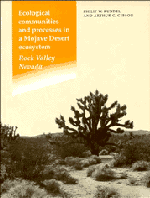Book contents
- Frontmatter
- Contents
- Preface
- Historical prologue on Rock Valley studies
- 1 Introduction to the Mojave Desert
- 2 Physical geography of Rock Valley
- 3 Adaptations of Mojave Desert plants
- 4 Desert perennials of southern Nevada
- 5 Mojave Desert annuals
- 6 Adaptations of Mojave Desert animals
- 7 Mammals
- 8 Reptiles
- 9 Birds
- 10 Arthropods
- 11 Soil organisms and seed reserves
- 12 Nitrogen cycling
- 13 Human impacts on Mojave Desert ecosystems
- References
- Species index
- Main index
11 - Soil organisms and seed reserves
Published online by Cambridge University Press: 19 October 2009
- Frontmatter
- Contents
- Preface
- Historical prologue on Rock Valley studies
- 1 Introduction to the Mojave Desert
- 2 Physical geography of Rock Valley
- 3 Adaptations of Mojave Desert plants
- 4 Desert perennials of southern Nevada
- 5 Mojave Desert annuals
- 6 Adaptations of Mojave Desert animals
- 7 Mammals
- 8 Reptiles
- 9 Birds
- 10 Arthropods
- 11 Soil organisms and seed reserves
- 12 Nitrogen cycling
- 13 Human impacts on Mojave Desert ecosystems
- References
- Species index
- Main index
Summary
The soil environment contains a variety of organisms not treated in previous chapters that yet play major ecological roles in many processes of carbon and nutrient fluxes. These organisms include cryptogamic plants living on the soil surface, such as soil algae and cyanobacteria, lichens, and bryophytes. Although at Rock Valley they do not form a large cover or biomass, such cryptogams provide important nitrogen inputs to many other desert ecosystems. Within the soil matrix occur many types of organisms, including a microflora of bacteria, actinomycetes, and a variety of fungi, and a microfauna that is dominated by such microarthropods as collembolans and mites, nematodes, and protozoa, which have a significant influence on decomposition processes in soil. In addition, soil reserves of vascular plant seeds provide a critically important food resource for granivorous animals (Chapters 7 and 9) as well as a critical pool for future establishment of herbs (Chapter 5) and shrub species (Chapter 4) when favorable rains occur.
CRYPTOGAMIC PLANTS
Cryptogamic plants are generally much less abundant in dry desert ecosystems than in more mesic habitats. Nevertheless, even small biomasses of some of these groups may be ecologically important. This is particularly true for soil crusts and lichens with cyanobacteria (blue-green algae) symbionts, which are able to fix atmospheric nitrogen. General structure and function of soil crusts in the stability of soils from arid and semiarid lands has been reviewed in detail by West (1980).
Shields and Drouet (1962) described the general distribution of terrestrial algae and cyanobacteria of NTS from soil samples taken from 1957 to 1959 in Yucca Flat, Frenchman Flat, and Jackass Flats.
- Type
- Chapter
- Information
- Publisher: Cambridge University PressPrint publication year: 1996



